Echinacea: planting, care, choosing a place and the best varieties
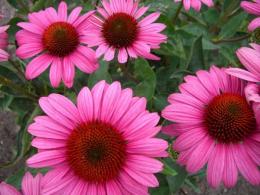
For several centuries, people have been cultivating a variety of flowers from the Asteraceae family. The genus Echinocea is no exception. This genus includes about 10 species. Common in gardening echinacea purple, as well as varieties and hybrids obtained with its participation. Thanks to many years of breeding work in recent decades, plants with flower colors have been obtained:
- white
- orange
- yellow
- red
- purple
We will try to figure out in what area Echinacea will take root, in planting and caring for it, how to choose a place for it and the best varieties of plants for the garden.
Content:
- How to choose a place for Echinacea, the best varieties for the garden
- Planting echinacea in the garden
- Caring for Echinacea
How to choose a place for Echinacea, the best varieties for the garden
The plant was first discovered in the eastern part of the modern United States. In the 18th century, taxonomist C. Linnaeus classified the plant as belonging to the genus Rudbeckia. A few decades later, several differences between Echinacea and Rudbeckia were noticed and the plant was separated into a separate genus.
It turns out that the bracts of rudbeckia are soft, while those of echinacea are not only harder, but also prickly. It is for this reason that the flower got its name from the Greek word prickly. When choosing a place for echinacea, you need to remember that most often it is cultivated as a perennial herbaceous plant and will grow in the garden for several years in one place.
Lighting and soil
Echinacea's need for sunlight is quite high. If possible it is needed plant in a sunny place.As a last resort, the flower can grow either in partial shade or with a fairly long period of continuous light during daylight hours.
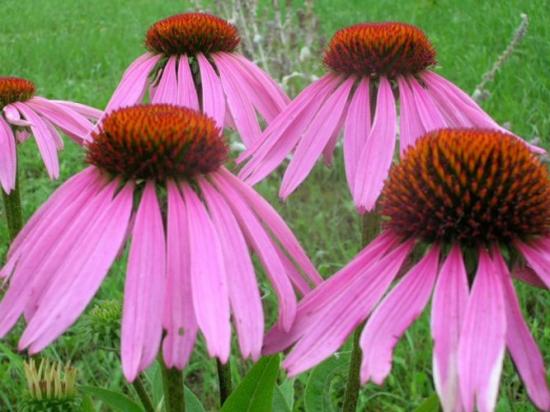
There are no special requirements for the mechanical composition of the soil for planting Echinacea. The plant grows well in the most wasteful lands. In their homeland, they took a fancy to railway embankments and populated them by self-seeding. Echinacea can grow in any area with moisture-permeable soil.
It is desirable that it be soil with a neutral or slightly alkaline reaction. To create more favorable conditions, you will need fertile soil with good moisture.
In dry summers, additional watering is needed every 5-6 days; without this, the flowers may lose their decorative appearance and reduce the number of buds. An important characteristic is winter hardiness. Almost all cultivated varieties overwinter without shelter. In very harsh winters you can cover it with spruce branches.
Variety selection
When choosing varieties echinacea, its purpose in the garden should be taken into account. This plant can be used as a border plant, used in mixed plantings, or grown in separate groups. Echinacea is also grown for cutting and for use in winter dry compositions. Echinacea has two types of flowers; they are collected in inflorescences of a basket.
Video about growing echinacea:
Reed flowers are located along the edge, they are elongated, up to 4 - 8 cm. Tubular flowers are collected in the center, they are most often red or brown. Now varieties with double flowers have been obtained. In addition, Echinacea is classified as a medicinal plant and is widely used in folk medicine.
The best varieties and hybrid forms are:
- Piccolino - dwarf variety, no more than 0.3 m high, double flowers
- Little Magnus - low variety, 35 - 46 cm, purple flowers with a bright orange - bronze center
- Irresistible - medium-sized variety, up to 80 cm, double flowers, red-orange
- Southern Belle - tall variety, height more than 1.0 m, one of the first to bloom and blooms continuously for up to 12 weeks, flowers are medium-sized, pink, double
- Mikshake - a bush up to 0.9 m high, opens up to a hundred flowers at a time, the flowers are white, double in the shape of pompoms
Let's try to figure out how and when it's best plant Echinacea.
Planting echinacea in the garden
There are three main ways to grow echinacea in the garden. This is done either by direct sowing of seeds directly into the ground, or by sowing seedlings, or by dividing the bush.
Sowing Echinacea for seedlings, care after planting
This method should be used when breeding rare varieties and a limited number of seeds. Sowing of seedlings is carried out around mid-March. Seeds are placed in planting boxes with neutral, pre-moistened soil.
The top is covered with a thin layer of sand and it is also sprayed. The emergence of seedlings can be observed after two to three weeks. Although there are cases of seed germination in the fourth or fifth week.
Caring for seedlings comes down to systematically moistening the soil. In mid-May, seedlings are planted in a well-dug bed. It is advisable to add rotted manure when digging. Immediately after planting, Echinacea is well watered until rooting. In the future, care comes down to removing weeds and loosening the soil.
Sowing seeds in open ground and propagation
To the prepared place seeds Echinacea is sown in the second ten days of May. The sowing site is regularly moistened. The seeds begin to sprout after two weeks. They are cared for in the same way as when growing seedlings.
In early spring, as soon as the leaves appear on the surface, the bush is dug up and divided into 3 - 4 parts. The cuttings are laid out in the prepared holes and covered with soil. It is important to leave the root collars above the ground.
Caring for Echinacea
The plant does not require special care. It is important to regularly remove weeds, loosen the soil and give the plant warm spraying in hot weather. If you regularly cut off baskets of inflorescences from Echinacea that are already fading, you can achieve abundant, long flowering.
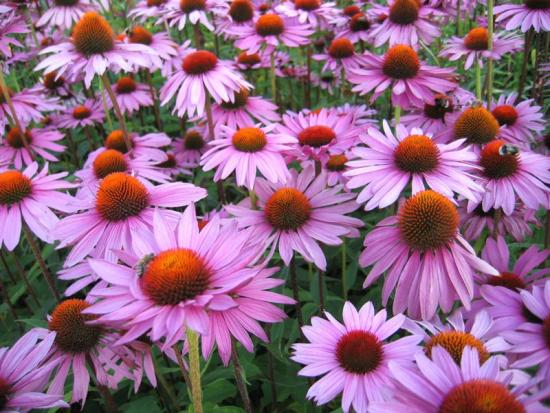
Plants are resistant to disease, but with excess moisture they can suffer from fungal diseases. In order to avoid fungal lesions, it is important to maintain the humidity regime. If the plant is sick, then it can be sprayed with a solution of any fungicidal agent, after removing the affected parts.
If planting and care are organized correctly, echinacea will delight you with its flowering in the garden, and when cut into bouquets, it will also become a decoration for your home.

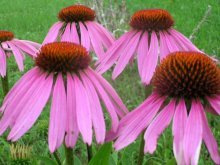
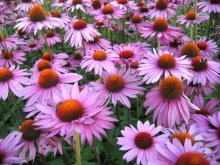
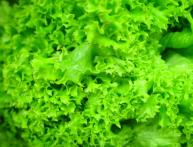
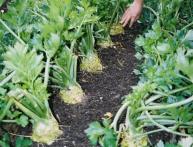
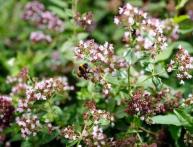
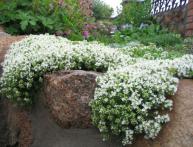
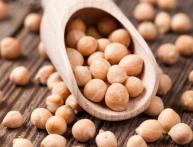
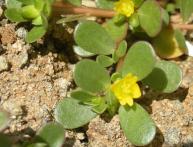
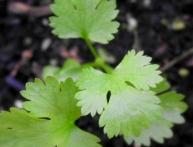

Comments
I was surprised to read in the article that Echinacea flowers can come in so many colors. The only thing that grows on my plot is this ordinary purple echinacea. Echinacea sows very well on its own, I have already shared this flower with all my relatives.
Excellent flowers, very pleasing to the eye, they make our flowerbed look more cheerful, it’s nice that they don’t require special care. The main thing is not to forget to water and spud, and of course, weed.
I like the fact that the flower is absolutely unpretentious; wherever you plant it, it grows there. It was recommended to me by a friend to whom I once complained that the flowers in my dacha were not growing well. And indeed, echinacea has taken root well with me without much effort.